|
Journal of a Sabbatical |
|||||||
|
China Trip 2000 |
|
drepung monastery and norbulingka |
|||||
|
|
|
|
|||||
|
Today's Reading: The Story of the Stone (a.k.a. Dream of the Red Chamber) by Cao Xuequin Some Drepung links: Drepung Monastery - the Drepung Monastery in exile Drepung Monastery in Lhasa - from tibettrip.com |
|
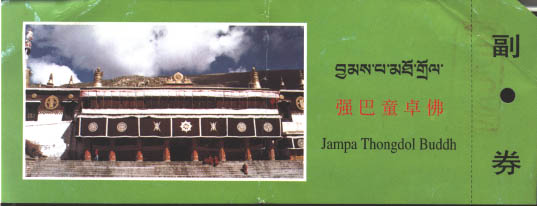 The scheduled itinerary listed Drepung Monastery, Sera Monastery, and Norbulingka all in one day. We made it to Drepung Monastery and to Norbulingka but had to skip Sera.
The big yellow dogs asleep in the sun fit in perfectly with the color scheme and there are way more of them here at Drepung Monastery than there were at the Potala or at the Jokhang Temple. I must still be suffering from the sickness I had yesterday because although I was staring at one big yellow dog and never took my eyes off him I never saw him move and yet suddenly he was three feet further to the right and facing in the opposite direction. From reading the guidebooks I expected packs of wild rabid dogs to be roaming the streets of Lhasa threatening tourists and pilgrims. These dogs seem barely alive though. All they do is sleep. They never move. It's uncanny. You can hear them barking at night though. And now back to our main topic... Like I said Drepung is big. The Drepung Monastery is the largest of the three Yellow Hat sect monasteries. At one point as many as 10,000 lamas and monks lived and studied there. Only about 500 or so monks live there now but the monastery is fairly lively. Like Jokhang and unlike the Potala, real religious life seems to be going on here. The main assembly hall, supported by 190 huge pillars (George made such a big deal of the number that it stuck in my mind but the guidebook says 180, anyway a lot of huge columns), has cushions for many monks (supposedly the main hall can seat as many as 10,000 lamas). They were worn and used looking enough that I could believe they're actively in use. Yellow hats are hung up near the rows of meditation cushions.
A Buddha statue said to have been unearthed by Tsongkapa
is enshrined on the second floor. Also enshrined on the
second floor is the white conch shell with a
counterclockwise spiral believed to have been buried by a
disciple of Sakyamuni Buddha, also unearthed by Tsongkapa
(who must have been quite the archeologist) and passed on to
his disciple Jamyang Choje who is credited with building the
monastery in 1416. I drank holy water from the holy
There's also a Tara chapel on the second floor. The Tara images in this particular chapel are responsible for protecting the monastery's drinking water (also wealth and authority - in that order). No disrespect to Tara, but the solar boiling apparatus gave me a much more secure feeling about the drinking water. Speaking of large containers the monastery kitchen is impressive for its huge kettles and cooking pots. I tried to imagine cooking for 10,000 monks or even the 500 who live here now but it boggles the mind.
Drepung is divided into four colleges, with different specialties. I managed to visit Ngagpa (that's the one near the holy metal rod shrine) and Loseling (the largest of the colleges and the only one I'd heard of before). One of the chapels in the Loseling College has 16 arhats (not quite as amazing a sight as 500 arhats). I'm a little fuzzy about what was in which college or chapel after that. I think I reached religious icon overload at about the same time a wave of extreme fatigue and nausea washed over me. I was relieved to go back to the hotel for lunch, at least for the rest if not the lunch itself. My appetite hasn't fully made the altitude adjustment yet. At this point were were all exhausted. Carol and I decided with George that all we could handle in the afternoon would be Norbulingka. Rosalie dropped out of the group to do her own thing. 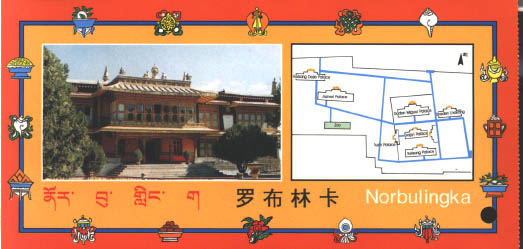
The word Norbulingka means 'Jewel Park'. It is a large park full of trees, ponds, gardens, palaces, and pavilions. Construction was first started there by the Seventh Dalai Lama around 1750 (whoa, something that wasn't built by Songtsen Gampo?). He selected the location because of a medicinal spring, in which he bathed for health reasons. Norbulingka has been used as a summer residence, retreat, and recreation area by successive Dalai Lamas since then. Most of the buildings were constructed during the twentieth century by the Thirteenth and Fourteenth Dalai Lamas.
My favorite thing (besides dancing with the buskers) at Norbulingka was the mural depicting the entire history of Tibet in the Dalai Lama's living quarters. Starting with monkeys who came down from the trees and planted barley and right up to the Dalai Lama meeting with Chairman Mao. I guess the Tibetans don't get all bent out of shape at the idea that humans are related to monkeys the way Americans do. (Whatever would the Kansas school board make of this mural?) We walked through the park admiring the pines and cypresses with dendrological eyes. We can't help it. Life revolves around conifers. George picked a couple of pine cones and cut off a small branch for us. Whatever palace building we were walking toward was closed when we got there. I think it was the part with the medicinal spring. Anyway, we walked back tired. We must have looked tireder than we felt because a woman selling cold drinks from a cart along the path put a chair in the middle of the path and motioned for us to sit down. With George translating the woman told us we were very brave to come to Tibet at our age. Old? OK, Carol has white hair but me? I won't be 50 'til April! A group of young women and girls gathered around us and we tried to converse with them through George. One woman looked to be about 15 years old. We asked her age. 23! An older woman, who I would have guessed at 45 or so turned out to be 32. There's some window of time in which Tibetan women look very young for their actual age but then they age really fast. I don't think sunscreen is widely known in Tibet. Images, impressions, sensations all started to mix together. It seemed like Lhasa was just whirling all around me in a jumble of vignettes like the yak riding on the back of one of those three-wheeled motorcycles, the monks carrying huge prayer wheels, the beggars with runny noses (handkerchiefs or Kleenex seem unknown in Tibet), the men rubbing my belly for luck, the oversize Chinese sculptures of yaks and mountain climbers in the newly built plazas... |
|||||
|
Copyright © 2000, Janet I. Egan |
||||||
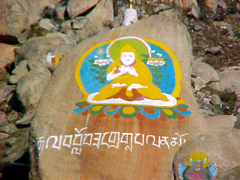 Drepung
is huge, composed of numerous buildings nestled into a very
steep mountainside (Mount Guopei). The overall color scheme
is kind of a maroon and gold like the monks' robes. Most of
the lower walls are white. The upper walls are maroon and
the roofs are gold-covered and decorated with intricate
designs.
Drepung
is huge, composed of numerous buildings nestled into a very
steep mountainside (Mount Guopei). The overall color scheme
is kind of a maroon and gold like the monks' robes. Most of
the lower walls are white. The upper walls are maroon and
the roofs are gold-covered and decorated with intricate
designs.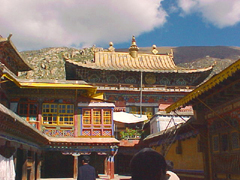 The
monastery contains many beautiful thangka paintings of
Avalokiteshvara (God of Mercy as George keeps saying), Green
Tara, White Tara, fierce guardians, all the usual suspects,
numerous images of Yellow Hat founder Lama Tsongkapa,
several past Dalai Lamas, kings of Tibet (especially
Songtsen Gampo).
The
monastery contains many beautiful thangka paintings of
Avalokiteshvara (God of Mercy as George keeps saying), Green
Tara, White Tara, fierce guardians, all the usual suspects,
numerous images of Yellow Hat founder Lama Tsongkapa,
several past Dalai Lamas, kings of Tibet (especially
Songtsen Gampo).  sea
shell as well as pouring it over my head. They do
boil the holy water. I realized that after I'd already
spontaneously swallowed it and was then about to panic. I
saw solar collectors that boil large containers of water on
the roof and in the courtyard.
sea
shell as well as pouring it over my head. They do
boil the holy water. I realized that after I'd already
spontaneously swallowed it and was then about to panic. I
saw solar collectors that boil large containers of water on
the roof and in the courtyard.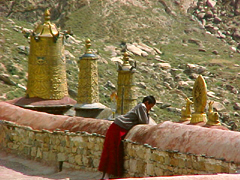 The
crowds were pretty dense, though not as bad as at the
Potala. I got very claustrophobic near the small shrine to
Manjusri where pilgrims are supposed to touch some kind of
metal rod or sword or something to get wisdom. I never made
it to the holy metal rod. Instead I went out on the roof and
checked out the sleeping dogs, the monks selling postcards
and amulets, and so on. I bought a good luck amulet for
Joan-west. I asked the monk for something specific to good
luck in your studies, but he suggested a general good luck
charm.
The
crowds were pretty dense, though not as bad as at the
Potala. I got very claustrophobic near the small shrine to
Manjusri where pilgrims are supposed to touch some kind of
metal rod or sword or something to get wisdom. I never made
it to the holy metal rod. Instead I went out on the roof and
checked out the sleeping dogs, the monks selling postcards
and amulets, and so on. I bought a good luck amulet for
Joan-west. I asked the monk for something specific to good
luck in your studies, but he suggested a general good luck
charm.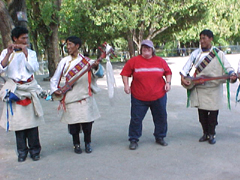 During
the Shoton Festival (George kept calling this the "cheese"
festival. It wasn't until much later I realized it was a
yogurt festival - which makes a lot more sense.), the
eastern part is packed with people enjoying Tibetan opera
performances. From the way George was talking, I didn't
expect to see any performers here today because it's not the
cheese festival. However, a troupe of buskers was playing a
lively tune and dancing a side to side foot-tapping kind of
dance. I was tapping my feet to the rhythm, wishing I could
learn the dance. A Chinese woman went up and danced with the
musicians. Carol encouraged me to go ahead and ask them to
teach me the dance while she took a picture of me. I was
laughing and trying to dance despite the altitude. I
attracted a much larger crowd of onlookers, which I hope
translated into more money for the musicians. They were
really good sports.
During
the Shoton Festival (George kept calling this the "cheese"
festival. It wasn't until much later I realized it was a
yogurt festival - which makes a lot more sense.), the
eastern part is packed with people enjoying Tibetan opera
performances. From the way George was talking, I didn't
expect to see any performers here today because it's not the
cheese festival. However, a troupe of buskers was playing a
lively tune and dancing a side to side foot-tapping kind of
dance. I was tapping my feet to the rhythm, wishing I could
learn the dance. A Chinese woman went up and danced with the
musicians. Carol encouraged me to go ahead and ask them to
teach me the dance while she took a picture of me. I was
laughing and trying to dance despite the altitude. I
attracted a much larger crowd of onlookers, which I hope
translated into more money for the musicians. They were
really good sports.